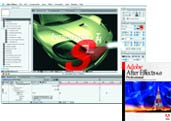
Adobe After Effects 6 offers expanded text animation capabilities.
|
Manufacturer: Adobe (www.adobe.com)
Latest Compositing Product/Release Date: After Effects 6.0, shipped third quarter 2003
New Features: Big 6 - Integrated text engine from Photoshop, new motion tracker (35 to 50 times faster), new paint engine (from Photoshop), performance improvement (Open GL support), new keyer (Pro version only, pulls high quality keys with minimal amount of effort), added scripting (Pro version only, improves production workflow).
Projects: Spy Kids 3D
Price Point: $699 (standard), $999 (professional)
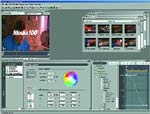
Media 100's 844/X offers realtime compositing.
|
Manufacturer: Apple (www.apple.com)
Latest Compositing Product/Release Date: Shake 3, shipped June 2003
New Features: Available to Mac OS X, Linux and Irix customers - film grain simulation and tracking on rotoshapes and paint strokes. For compositors in commercial post - powerful audio capabilities for easier synchronization of visual effects with audio, including the ability to automatically animate visual effects based on sound and view, slip or slide audio waveforms against animation curves.
New Mac OS X-only features include Shake Qmaster network render management software that allows visual effects artists to easily distribute rendering tasks across a cluster of Apple Xserve 1U rack servers or desktop Power Mac G4 and G5 computers for maximum performance and efficiency.
Projects: Feature films: Finding Nemo, The Matrix Reloaded, X-Men2, The Italian Job, The Hulk, The League of Extraordinary Gentlemen
Price Point: $4,950 (Mac OS X), $9,900 (Linux/Irix)
Existing Shake for Linux/Irix/ Windows customers will continue to be given the option to double the number of their existing Shake licenses at no additional cost by migrating them to Shake on Mac OS X.
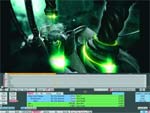
This screen grab illustrates Quantel's integrated plug-in environment.
|
Manufacturer: Avid (www.avid.com)
Latest Compositing Product/Release Date: Avid|DS Nitris, released third quarter 2003
New Features: This latest NLE product offers compositing on unlimited layers and layer duplication, intelligent caching to improve interactive performance, direct manipulation DVE for each layer with motion path editor and realtime wireframe preview, global DVE for manipulating several layers at once, motion stabilization and destabilization, corner-pinning, and painting directly on any layer.
Projects: More than 20 fall TV programs are using Avid|DS HD to finish in HD. Shows include LA Dragnet, Lyon's Den (Matchframe Video), Hack, Smallville (Modern VideoFilm), Third Watch, Las Vegas (Level 3 Post).
Price Point: Avid|DS Nitris Editor , $78,995, Avid|DS Nitris system, $145,000. For existing Avid|DS HD customers, hardware upgrades to the Nitris system are $35,000.
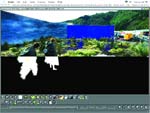
Apple's Shake, which was used on the Lord of the Rings films, is available to Mac, Linux and Irix users.
|
Manufacturer: Discreet (www.discreet.com)
Latest Compositing Product/Release Date: Combustion 3 for Windows, shipping fall 2003; Mac version ships in early 2004.
New Features: This latest version has features that allow artists to take on new kinds of work while spending less time switching applications. The new edit operator lets artists assemble video with transitions inside of Combustion. Because the editors remain live, any necessary changes can be easily made during the production process.
It also has added expressions (to control any keyframeable parameter in Combustion from Javascript), customizable brushes and Macromedia Flash output (for motion graphics designers who don't have to learn a new application to take on Web graphics.
Projects: Radiohead's There There by Collision Films (nominated for MTV Best FX), TV series Mutant X and Playmakers and many commercials.
Price Point: $995. Upgrades from version 2, $199
Manufacturer: Discreet (www.discreet.com)
Latest Compositing Product/Release Date: Inferno V.5.3.1, Flame and Flint V.8.3.1/shipping 3rd quarter 2003. At IBC, Discreet demoed features for future releases Inferno 5.5, Flame and Flint 8.5, the upcoming minor releases planned for January 2004.
New Features: Those new features include Discreet's next-generation Master Keyer, 10-bit media support, Color Warper enhancements; the addition of Discreet's advanced Gmask gradient technology to the Discreet Keyer; new Logic Ops options (transparency, blend, divide); and additional capabilities in the Burn-In tool.
Discreet's Master Keyer is based on new algorithms that enable artists to interact more directly with the image, yet provide the intelligence to guide the keying process with greater sophistication and precision. The Master Keyer features three-dimensional color isolation technology designed to facilitate the keying of poorly set up effects shoots, including such challenges as badly lit green/bluescreens, HDCAM compression or film grain.
Projects: Inferno - HBO's Carnivale (A53), spots including Nike Presto (The Moving Picture Co.), Pepsi Twist featuring the Osbourne family (Quiet Man/NY). Flame - spots including VW Beetle (Brickyard VFX/Boston), shows including The West Wing (Level 3 Post/Burbank).
Price Point: Starts at $98,000. Pricing for Discreet's visual effects systems varies depending on geographical region and system and storage configuration.
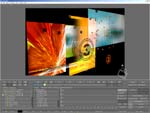
Combustion 3's new edit operator lets artists assemble video and transitions inside the app.
|
Manufacturer: Eyeon Software (www.eyeonline.com)
Latest Compositing Product/Release Date: Linux version, shipping fourth quarter 2003; DFX+
New Features: "Eyeon Software has been very busy with recent corporate partnerships, making certain that Fusion remains the most flexible and interoperable compositor on the market," says product manager Isaac Genuard. "For example, DFX+, our digital video compositing solution, is now bundled with NewTek LightWave 8.0 upgrades as well as the dpsVelocity and dpsQuattrus from Leitch Technologies. At this past IBC, we showed how Avid Adrenaline and Digital Fusion collaborate together seamlessly."
Three new plug-in vendors now support Fusion: Algolith, GenArts and Pixel Farm.
Projects: Feature films: Spy Kids 3D, Chicago, plus upcoming The Matrix Revolutions, The Last Samurai; Music videos for Moby, Aerosmith, Shania Twain; TV series Alias.
Price Point: Digital Fusion $5,995, DFX+ $995 (without modules), $2,495 with all modules
Manufacturer: Media 100 (www.media100.com)
Latest Compositing Product/Release Date: 844/X Version 2.0/released May 2003
New Features: The foundation of 844/X's power realtime keygrame benefits from several new features and improvements, including Curve Editor usability enhancements (users can now select and drag multiple keyframes), new Parameter Editor features (TimeFX time remapping plus support for new plug-ins) and interactive viewer window (users now have direct image manipulation support and a new reference frame feature that allows you to view the same frame before and after an effect is applied). There is also advanced matte design whose highlights are new spline-based rotoscoping tools for precise control over frame-by-frame matte adjustment.
Projects: Commercial and branding projects for Samsung and South Land Galleria (for Delaplaine Creative/San Francisco), promo spots for Showtime Network (for Editology/New York).
Price Point: 844/X at $24,995.
Manufacturer: Pinnacle (www.pinnaclesys.com)
Latest Compositing Product/Release Date: CineWave 4.0.1, September 2003

Compositing Products
|
New Features: Commotion Pro is a subset of CineWave, a hardware/software-based system whose new release features 1) space saving high quality offline support - for realtime capture form both SD and HD sources into popular offline formats Photo-JPEG and DV25/DV50 as well as CineOffline, 2) realtime effects and support - for up to five uncompressed realtime tracks, 3) high precision 32-bit floating point rendering with Final Cut Pro 4's HDR image processing engine.
Projects: TV shows Moments in Time, The Desert Speaks, The Isaac Mizrahi Show.
Price Point: Starts at $3,995.
Manufacturer: Quantel (www.quantel.com)
Latest Compositing Product/ Release Date: iQ and eQ version 2/December 2003

Compositing Products
|
New Features: 1) 3D Aware Compositing environment - puts the environment in there that fully understands 3D space. 2) the Process Tree - a different, more technical way of looking at a composite. Useful if users are building up a complex composite. Version 2 allows users to freely switch back and forth between the Process Tree view and the traditional blender view and work in the environment that's most appropriate for the job. Projects: iQ feature films: Once Upon a Time in Mexico, Bad Boys II, Terminator III. eQ: promos and commercial projects.
Price Point: QEffects, $12,000; eQ-$180,000; iQ-$380,000 to $500,000.